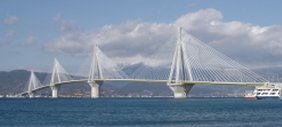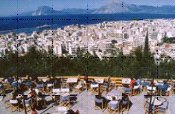Venue-Sights for Visiting
Useful information about the Sights interesting for visiting
This is a page with general information to whom are wish to visit places and archeological monuments nearby the conference venue.
About Venue:
Greece,
Patras,
Rio,
Univ. of Patras,
Conference & Cultural Centre
Travel Info:
Transportation,
Passport/Visa,
Currency,
Time Zone,
Electricity,
Weather
Sights for visiting:
Rio,
Patras,
Olympia,
Delphi,
Mycenae,
Epidaurus
RIO![]()
Rio's Castle,
Rio-Antirio Bridge
Rio's Castle
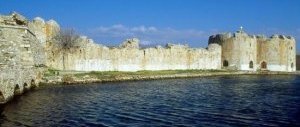
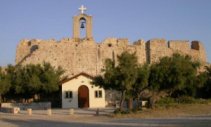
![]()
The first fortification of the pass was made
in 1499
by Bayazid
II. It was smaller in
area and with a double circuit and moat. In 1532 it was taken by the
Spaniards and Andrea Doria, and
later
retaken by the Turks. In 1603 the Knights
of Malta wrought significant destruction. In 1687 it was taken by Morosini.
Drastic repairs were made and it received the form it has today: new
towers - bastions, strengthened ramparts. The
castle was
seized by the
Turks in 1715, and in 1828, after a siege, the Turks surrendered it to
General Maison.
It was repaired and handed over to the Greeks. The
castle,
Greek:castro
(kastro),
was used as a prison for a considerable time. During World War II the
Germans established themselves there
and later was used by the Greek army as a camp.
Cleaning and removal of earth was done in 1980-81 and in 1984 the wall of
the eastern side of the
castle was restored.
Today it is using during the summer for outdoors performances and is the
place where concerts are given mainly and especially by young music
groups.
![]()
Rio-Antirio Bridge![]()
|
|
 |
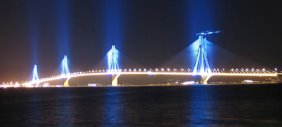 |
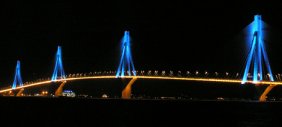 |
The bridge of Rio - Antirio connects
the Rio
from one side of Patraicos gulf, sited on the West-Northern Peloponnesus,
with the Antirio to the other side of Patraicos, sited on South-Western
Sterea Hellas. The bridge was opened for first time to allow the Olympic
flame to cross, but to the traffic it was opened a few days later. It is
characterized as the biggest cable stayed bridge of multiple openings in
the world and is constructed by particularly specialized methods, creating
a worldwide originality of manufacturing bridges of this kind, This was
because of the environmental characteristics of the
region, as are the big depth of foundation, the strong seismic activity
coupled by the possible tectonic movement, the mediocre quality of subsoil
in the seabed of sea and other. Some
technical characteristics of the bridge are:
length 2.252 metres (2.883 metres with the addition of
bridges of access at each end), three central openings of 560
metres and two lateral ones of 286 metres, and
a unique base
in a depth of under 65 m below the surface of the sea.
The bridge
is hanged in four
pylons over the sea and supported in two
akrovathra
(piers) at each coast. The
deck width is
27,2 metres allocating
two lanes of circulation (plus a hard shoulder) per
direction. It is continuous in all the length
and completely hanged from the heads of four pylons with 368 cables,
distributed per 12 metres at length of deck in eight teams using
some 40 kilometres of cables of a
weight of about
5.000 tons. Each pylon has a maximum
height of 227 metres and a weight of about 170.000 tons.
The bridge
is also characterized as a construction of high art and aesthetics. During
holydays and weekends the bridge is lighten at nights and this adds a more
magnificent view to it. The bridge of Rio-Antirio symbolizes generally the
Greek development today and specifically the cities of Rio and Antirio and the area
around.![]()
PATRAS![]()
Fortress,
Dassylion-Tourist kiosk,
Roman Odium,
Municipal Theatre,
Saint
Andrew's Cathedral;
Museums:
Archaeological,
Folk Art,
Historical,
Press,
Municipal Gallery;
Squares:
Georgiou,
Olga's,
Trion Symahon,
Ipsila Alonia,

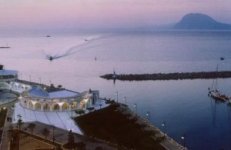
![]()
Patras is the capital of the region or prefecture and for the year
2006 the civilization capital of European Union.
It owes its name to Patreas, chief of the Achaeans. The city is among the most important in
Greece, and the largest in the Peloponnesus. It is also a major
transportation centre, linking the country with Italy and the Peloponnesus
with the Ionian islands. The city extends from the shore up to the Castle.
It is divided into two parts, the upper and the lower, whose layout, parks
and piazzas give it a definite distinction.
The old city, at the foot of the castle, still has quite a number of
attractive neoclassical houses, while the lower city has many mansions,
such as those housing the Municipal Theatre, the Odeon, etc. The Cathedral
of St. Andrew, the city's patron, rises majestically above the lower city.
To the left of it stands an older church built on the site of a Byzantine
church that was destroyed by the Turks.
From here Trion Navarchon street leads to Psila Alonia - the "balcony'' of
Patras - a lovely spacious square with slender palm trees and a sun dial.
Patras possesses a fine archaeological museum, an art gallery and a
printing museum. Dominating the city from on high looms the ruined shell
of the castle, whose grounds have been transformed into a park. From here
you have a view of the whole city and the sea beyond. Patras' famous
Carnival - a festive sampling of its citizens' imagination, humour and
high spirits - attracts thousands of visitors every year. Finally, the
city's innumerable pastry shops, its quiet little cafes, its wide range of
taverns, its lively streets bustling with locals, foreigners and
transient travellers complete the picture of Patras, beautiful and
celebrated throughout![]() Greece.
Greece.
Fortress![]()

![]()
The
fortress of Patras was built during the second half of the 6th century, on
top of the ruins of the ancient acropolis. It is situated on a low hill of
Panachaikos Mountain, at a distance approximately 800 meters from the
coast. Its walls surround an area of about 22725 s.m and is constituted by
a triangle outer enclosure, loaded with towers and ramparts, initially
protected by a deep moat, and an inside enclosure that raises high in the
NE corner and is also surrounded by a moat.
It was built by Justinian, after the destroying earthquake in 551 using
material from buildings of the B.C. era for the defence of the region and
its citizens. In the centuries that followed and up to the Second World
War, it has been in constant use for the defence of the city, but also as
an administrative and military centre.
During the Byzantine Ages, until the entrance of the Franks (1205) it was
besieged by the Slaves, Saracens, Bulgarians, Normans etc, though without
any of them achieving to besiege it. In 805 AD the people of the city were
besieged in the castle by the Slaves and the Saracens and their victory,
attributed to a miracle of the Patron Saint Andrew, was important for the
restraint of the barbaric invasions in the Peloponnesus.
The Frank Crusaders developed it, reinforced it and dug a moat all around.
In 1278 it was mortgaged to the Latin Archbishop while in 1408 the Pope
ceded it for five years against a rental to the Venetians. It remained in
the hands of the Latin Archbishop till 1430, when it was set free by
Constantine Palaiologos. Constantine moved on to extension and repair of
the walls.
It was slaved, during the Turkish Occupation and it passed in the hands of
the Greeks in 1828, after its liberation by the French General Mezon.
Since 1973 the Castle is under the supervision of the 6th Committee of
Byzantine Antiquities. In the dismantling theatre (640 seats) that lies at
the interior enclosure, cultural celebrations take place every summer.
The building phases that are obvious on the castle are evidence of the
work that has been made from the various conquerors for its repair and
fitting in the development of the fighting technology.
Fortress: open 8.00 am-6.00 pm (except Mondays).![]()
On Sunday: 8.00 am-6.00 pm
Free Entrance
Tel:
2610623390
This
pine-clad hill is called the "veranda" of the Patraic Gulf, due to the
excellent view that it offers. Dassylion (small wood) lends itself for
promenades and jogging.
Roman Odium![]()
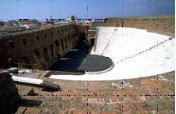
![]()
On the
West side of acropolis, at the upper town, lies the Roman Odium of Patras,
erected prior to the Athens Odium. (Herodeum, 160 AD). The Odium contains
all the basic parts of a theatre such as hollow, orchestra, proscenium,
scene and wings as well as 23 rows of seats, while its capacity is 2300
spectators.
After the establishment of Patras International Festival, Ancient Odium
constitutes its main venue, welcoming in the summer months, top Greek and
foreign artistic bands.
Roman Odium: open 8:00 am-2:30 pm except from Monday (free entrance)![]()
Tel:
2610220829
Municipal Theatre![]()

![]()
"Apollo"
Municipal Theatre is located on King George I Square and is considered as
the most impressive architectural ornament of Patras, while it is one of
the first opera theatres in Europe. It was built on 1872 according to the
designs of the German architect Ernst Ziller, with the financial
contribution of Patras' merchants.
![]()
Saint
Andrew's Cathedral![]()

![]()
The
old:
The two
churches dedicated to Patras' patron Saint, St Andrew, constitute a
national and Pan-Orthodox place of pilgrimage. The small Church was
erected during the 1836-1843 period at the spot where Apostle Andrew died
a martyr. It is a basilica
The New:
The new magnificent Byzantine church was founded in 1908 by King George I
and inaugurated in 1974 by Patras' Metropolitan Bishop Nikodimos.
It is the largest and most artistic church in the Balkans and one of the
largest across Europe.
The Church's central dome is 46m high and supports a five meter high
gold-plated cross and twelve smaller ones, symbolising Jesus and his
twelve disciples respectively.
The church's capacity is 5.500 persons.![]()
Museums:![]()
Archeological:
It is
one of the most important archaeological Museums in Greece. It is roofed
at the old mansion of Karamandanis' family and it is a legacy of Partas'
Municipality, located on the cross-road of Mezonos and Aratou streets,
just across National Resistance Square. At the two halls at the ground
floor are exhibited Antiquities from the Classic, Hellenistic and Roman
periods, mosaics, earthen and alabaster pots. Especially interesting are
the marble statue of goddess Athena, a large Roman mosaic pavement and the
ceramics from the Classic and Hellenistic period.
The limited space of the building does not allow the exhibition of all the
archaeological findings of the region (from the Mycenaean to Byzantine
periods), so most of them are stored in special areas until the new Patras'
Museum is erected.
The Archaeological Museum is open daily from 08:30am to 15:00pm. Monday
closed.![]()
Folk Art:
It was founded in
1977 by the Cultural Centre of Patras and is shielded in one of the
buildings of the Skagiopouleio legacy (Koritsas and Maurokordatou street).
Its purpose is to gather folklore stuff, to maintain and store it, as well
as its research, study and promotion.
Its articles include tools of rural life, furniture of folk residences and
objects of everyday use, means of transport as well as workrooms for the
elaboration of agricultural products, production of handy objects and
handiwork of every kind.
The Museum also disposes of a library and photographic archive while it
also hosts lectures, debates and exhibitions concerning folklore,
archaeology, musicology and maintenance of the architecture inheritance.
The various traditional workrooms (hat making, shoe making, waxing,
typography etc), exhibited in alternating program address to School and
University students.
![]()
Tel: 2610334713.![]()
Historical:
Founded
in 1973, when the efforts of its prime movers, Giannis Meletopoulos and
Theodors Papanagiotou, finally succeeded. The first one had the idea for
the creation of a space to roof the historic relics of Achaia and the
second one undertook its materialisation. The material collected was
initially placed at a room in the Municipal Library, to be transferred
later to Speech and Art Mansion, where it is sheltered till today.
The Museum is open from 11:00 to 13:00 daily. Friday and Monday closed![]()
Tel: 2610274962
Press:
It
operates since 1952 and its exhibitions include rare editions, newspapers
since 1875, magazines from Patras and the Peloponnesus, books and other
documents of historic value.
The Press Museum is shielded in the Building of the Editors' Union, in
Mezonos 20 street.
It is open from Monday to Friday 10-1. Tel:
2610310488![]()
Municipal Gallery:
The
Municipal Gallery of Patras was founded in 1988. Since 2000, it has been
working within the framework of activities organized by the Patras
Cultural Development Municipal Enterprise (DEPAP). Its objectives focus
mainly on organizing art exhibitions, simultaneous activities and many
educational projects.
The Municipal Gallery's objective is to present as many aspects of Art as
possible to the wider public, and also educate through art. Both
objectives are met successfully every year, as the Municipal Gallery
fulfils its educational and artistic mission. Its co-operation with the
National Gallery, the Benaki Museum, the numerous institutions and other
Galleries of Greece, have guaranteed the opening of many exhibitions, all
important samples of the history of Modern Greek Painting, Sculpture and
Engraving.
Amongst the Municipal Gallery's initiatives is to organize many
exhibitions-productions, either collective or retrospective, in order to
honour certain artists for their valuable and multi-dimensional work.
![]()
Squares:![]()
Georgiou:
It is the central square of the city
with the characteristic of two fountains placed in the year 1875.
It was a
place, where national dances and outdoor meetings, mostly of political
content were held.
It was the square of the political and cultural being of the city, the
place where the most important activities were taking place.
The contemporary George Square still constitutes the square of political
meetings, demonstrations, cultural activities and mostly carnival
celebrations. Olga's:
It is the square that carries the name of king George's wife, Olga. It
used to be called Omonoia Square. It is worth referring that on this
square, Kostis Palamas used to play as a child.
Trion Symahon:
This
particular square bears the name of the Three Alliance Forces with Greece
in the fight for liberation. These forces were England, France and Russia.
This square's old name was Custom Square, because it lied beside the
Custom House.
Ipsila Alonia:
It is considered to be the best
square in Patras. It is a hill,
wide on top.![]()
OLYMPIA![]()

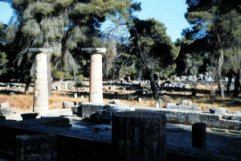
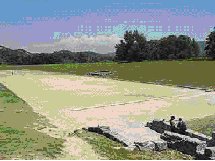
![]()
At the foot of the Kronion Hill stretches the space formed by the wedge of
land between the converging rivers of the Alfios and the Kladeos.
This was the site called the Sacred Grove of the Altis, regarded as
belonging to Zeus in which, in historically recorded times, the most
famous of Greek sanctuaries was estabilshed. Formerly it had been a place
of worship of pre-Hellenic deities. Every four years, athletic contests
were organized here in honour of Zeus, lasting seven days. Outside the
enclosure to the West, was the Stadium with a 45,000 seating capacity (men
only were allowed in). Access to the Stadium was along a vaulted passage
and, to the South, was the Vouleutirion where the Olympic Senate met.
Historically, the Olympic Games began in 776 B.C. Up to the 5th century
B.C., the sacred enclosure contained the Heraion, the Prytaneion, the
Pelopeion and the Hippodameion while, at the foot of the Kronion Hill,
stood the twelve Greek city treasures. The Olympic Games ceased in 393
A.D. after the edict issued by Theodosius the Great which forbade all
pagan festivals. They were revived for the first time after fifteen
centuries, in 1896 in the marble stadium in Athens.
Today, an international Olympic Academy functions at Olympia. There is
also a Museum of Olympic Games (tel. 26240 22 544) where data connected
with the Olympic Games are displayed together with a Collection of
commemorative postage stamps.
![]()
Archaeological Museum
![]()
The Museum at Olympia contains most interesting exhibits. Among various
other items, there is the most impressive collection of sculpture of the
austere style (first half of the 5th century B.C.). There are also the
pediments and metopes of the temple of Zeus.
The
twelve metopes, three of which are Gypsum casts, depict the twelve Labours
of Hercules. Two more masterpieces of 5th and 4th centuries. B.C. is to be
seen in the originals of the sculptors Paionios with his statue of Niki
(Victory) and of Hermes by Praxiteles.
![]()
DELPHI![]()

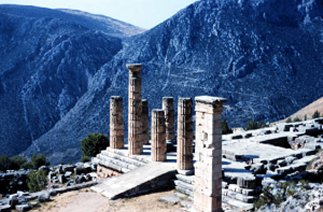
![]()
The myth recounts that at a certain moment Zeus released two eagles, one
from the East, the other from the West, and at the point where they met,
he threw the Sacred Stone, marking the center of the earth - the navel of
the world. At this point one of the most important oracles of antiquity
was developed and cultivated - the Delphic Oracle. The cave where the
divinity Gaia (Mother Earth) used to utter prophecies guarded by her son,
the serpent Python, dates from the second millennium BC (Mycenaean
period), was located on the way from the Gulf of Corinth to Central and
Northern Greece, in a region then called Pytho. When the god Apollo was an
infant, he killed Python, at the same time abandoning Delphi to purify
himself. After the purification took place, he returned to Delphi crowned
and took over the Oracle, which from then on belonged to him. Apart from
the mythical implications, this act symbolized the introduction of the
worship of Delphinios Apollo at Krisa (a town in Phokis, today Hrisso) by
the seamen of Knossos. The god became known as Apollo Pythias and the area
was called Delphi from that time on.
It was liberated in 590 BC, and it is from this date that the true history
and fame of Delphi essentially began.
Then
a
number of Sacred Wars broke out for control of the Oracle. In 191 BC the
Romans became masters of Delphi.
After
then,
nothing could halt Delphi's decline and eventually it ceased to be
regarded as the navel of the world.
![]()
The archaeological site![]()
The first excavations began in 1838 and were completed in 1935.
The Sanctuary of Apollo with the Treasuries (buildings where the
city-states kept votive offerings and religious vessels), the temples and
the perivolos (enclosure) lie on the south flank of Mt. Parnassos to your
right if you are coming from Arahova. The Doric temple of Apollo dominates
the centre of the Sanctuary. The Sacred Way leads to the temple and is
lined with Treasuries, monuments and offerings. Northwest of the temple is
the theatre (5,000 seats) where the Delphic Festivals were held, which had
as a central theme the representation of Apollo's victory over the serpent
Python.
![]()
The Museum![]()
The first building dates from 1902. The museum's collection consists
exclusively of objects of all kinds from the Sanctuary of Delphi. Among
its major works are: the navel of the world (a Hellenistic or Roman copy
of the Sacred Stone), the Sphinx of the Naxians (550 BC), the statue of
Antinous, the statue of Agias, the group of Thyiads (three colossal female
figures portrayed dancing around owered the metopes from the Treasuries of
Sicyon and Athens. the Karyatid and Zephyr from the Treasury of Sifnos,
the bronze Charioteer, the head of Dionysos.
MYCENAE![]()
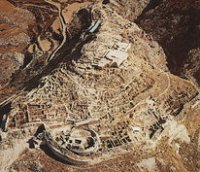
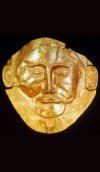
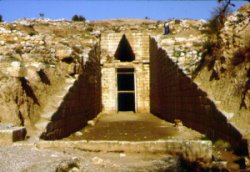
Mycenae
is a pre-historic citadel built on a site that commanded the greater part
of the plain, stretching southwards to the sea and the exit from the Pass
of Dervenakia.
It is fortified with Cyclopean walls with two gates (the Lion Gate and the
North Gate) as well as two small auxiliary exits. The first walls were
built around 1350 B.C. but the citadel itself assumed its presence form
around the year 1200 B.C.
A continuous supply of water was ensured by the Perseia Fountain close to
the entrance of the acropolis, while the proximity of the fertile plain
ensured food supplies.
The site's natural advantages thus enhanced its strategic position and it
was inhabited very early in Neolithic times. The period of its greatest
power, however, came at the close of the Late Helladic period (1600-1100
BC), which is also known as the Mycenaean period and with which many tales
and legends are associated. In 1100 BC Mycene was destroyed by fire.
![]()
Perseus, son of Zeus and Danae, founded Mycenae and the Perseid dynasty
provided many of its rulers. After the last of them, Eurystheus (famous
for the labors he imposed on Herakles), the Mycenaeans chose Atreus, son
of Pelops and Hippodamia, as their ruler.
In the 17th century BC, Mycenae began an extraordinary growth in wealth
and power that was to influence all of the eastern Mediterranean. At first
heavily influenced by that of Minoan Crete, spread throughout Greece, and
by 1400 BC Mycenaeans controlled the mainland and the Aegean, including
Crete.
![]()
Here you find ruins of private houses, Grave circle B with 14 royal tombs,
among which nine tholos tombs of the Atridae, the Treasure of Atreus, also
known as the Tomb of the Agamemnon, the Tomb of Clytaemnystra, the Tomb of
Aegisthus, and 12 tombs of private citizens. There is also the Mycenaean
Palace on the crest of the hill, a smaller palace further East, known as
the House of the Columns, the House of the Artists and, finally, at the
N.E. extension, the Secret Cistern.
Most of the more exceptional finds are on exhibit in the National
Archaeological Museum in Athens, like frescoes, gold jewellery, the gold
mask of Agamemnon.
![]()
EPIDAURUS
![]()
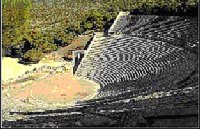
![]()
Open-air theatre
The main and most interesting monument of this area is the open-air
ancient theatre. It
Stands to the S.E. and is the best preserved theatre ιn the whole of
Greece. It was the work of the architect Polyklitos Junior (4th century
B.C.), built of limestone
with 12,000
seats
for equal
spectators. Every summer it comes alive. Attending a performance of
ancient drama in this theater is almost a mystical experience. At Epidavrus
the actors donít need to shout or speak loudly. The acoustics are so
perfect that the merest whisper can be heard in the last row.
![]()
Other monuments
Other interestic monuments are the Sanctuary of Asclepius, the stadium and
the museum where is exhibited pieces
from the Tholos and the temple of Asclepius, gypsum casts from pediments
(sculptures by Timotheos), Roman portrait statues, inscriptions, medical
and surgical instruments and
others.l.
![]()
About Venue:
Greece
Patras
Rio
Univ. of Patras
Conference
and Cultural
Centre
Travel Info:
Transportation
Passport/Visa
Currency
Time Zone
Electricity
Weather
Sights for
visiting:
Rio
Patras
Olympia
Delphi
Mycenae
Epidaurus
